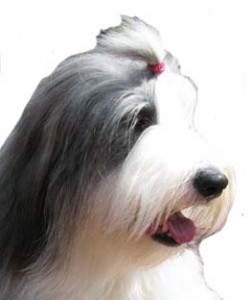Beware of the hair
February 9, 2015 – Teeth: Nothing distracts more than a morsel of meat caught amid a mouthful of otherwise pristine pearly whites. But an unsightly appearance is the least of the concerns that can spell trouble for the teeth. Humans can pick, brush, floss and gargle away unwanted dental debris, but what are dogs and cats equipped to do… they’re limited to loosing their teeth. Bacteria are commonly incriminated as the source of dental disease, but they couldn’t do it without food, and the harrowing help of hair. It’s true, bacteria do the damage, but hair along with imprudent dental aids (hoves, horns, bones, etc.) are accessories to their crimes. Chewing, sucking, licking, rubbing and, with the barbs on a cat’s tongue, combing all lead to a heap of hair between the teeth, and more importantly, between teeth and gums. What better way to provide bacteria with access to the root of the tooth?
Ears: Hair was designed to defend the ears, but what can pet’s do when the defense becomes offensive. A little hair is good, but a lot is just plain problematic. When heredity, anatomy or chronic irritation make it time to thin the herd; you can trim the hair, pluck the hair, chemically epilate the hair or electrocute the hair. All techniques have been used with variable success. Chemical and electrical methods are disturbing at best, which leaves trimming and plucking as the most viable options. Trimming is the safest, but when the hairs in the ear run amuck… it’s time to pluck.
Digestive tract: Technically called “Trichobezoars,” hair balls aren’t meant to intermingle with the stomach, intestines or colon. With its light weight, indigestible nature and tendency to ball up; hair is a major source of vomiting, irritable bowel and blockage. Since self-grooming is not likely to stop any time soon; it would be best for pets to have shorter hair, regular dead hair removal or a gluey laxative to prevent them from swallowing a lot of long locks.
Vulva and Prepuce: For females… it’s the invasion of the vulva hair, and for males… it’s the snarling of the sheath hair; both raise the risk of bladder infections. Keeping the unmentionables clean, dry and free of unruly hair, along with some powder periodically, will keep your pets smelling good, feeling good and licking less.
Paws: What’s worse for the paws than pitch? Pressure and hair mats. All three play a role in paws that pause. That’s right… pets are not pleased with anything that puts their paws in a predicament. If you see licking or limping then it’s best to be picky with the paws when it comes to grooming, cleaning and weight watching.
Eyes: Eyes are the windows to the soul, but they’re also hair magnets. Whether you prefer the hair around your pet’s eyes to be long for the show, or just let it go; it’s doing damage when in contact with their corneas. How long would you leave a hair on your eye? It hurts doesn’t it? Pets put up with the pain, and after time wears on, their eyes wear out. It’s best to train the hair away from the eyes with a braid, a barrette, a bow or a gel… if you want the eyes to stay well.
Bottom: And finally we end with your pet’s rear end. Hair looks great when it’s blowing in the wind, but when tangled in a mat of poop… it’s in the way of the passing, a problem that’s potentially impacting, a sight that’s distracting, and a source of smell that’ll have you wishing you had wound up… upwind.
Bottom line: Beware of the hair that lurks in the most improper places; it has the appeal we like to feel, but when off the track it must never come back.

